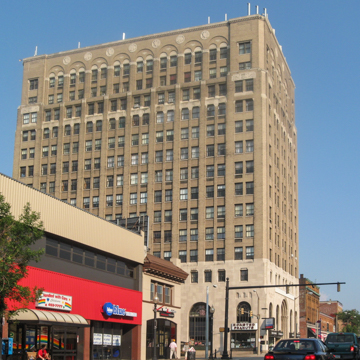You are here
Renaissance Centre (Erie Trust Company Building)
Erie was booming in the late 1920s, illustrated by the construction of two of its largest buildings, the Boston Store ( ER17) two blocks north and this, the tallest office building in Erie, which, at fourteen stories, offers unobstructed views in all directions. The Erie Trust Company, a c. 1900 incarnation of the Erie Dime Savings and Loan, was the wealthiest bank in town when it commissioned the New York City architectural firm to design this classical bank with Art Deco geometric touches. The tan brick building employs the base, shaft, and capital arrangement standard in tall buildings of the day. Grand limestone concentric arches highlight the State Street entrance and embody the Art Deco spirit by using charming stylized grotesques as capitals. The limestone base wraps around the first three stories and is punctuated by large arched openings that light the commercial spaces and mezzanine. The interior retains the original marble baseboards, walnut doorways, and bronze elevator doors. Edward Trumbull (1884–1968) painted murals on the mezzanine level depicting events in northwestern Pennsylvania's history. Five of the seven original murals remain and have been restored. Trumbull's murals also grace the walls of the Chrysler Building, Rockefeller Center, and Grand Central Station, all in New York City.
The building was commissioned in 1925 by the Erie Trust Company, but by 1934, it was in receivership. The commonwealth took possession and sold the property to local real estate magnate G. Daniel Baldwin in 1943. In 1996, Professional Development Associates bought the building and have since restored it for offices and retail stores.
Writing Credits
If SAH Archipedia has been useful to you, please consider supporting it.
SAH Archipedia tells the story of the United States through its buildings, landscapes, and cities. This freely available resource empowers the public with authoritative knowledge that deepens their understanding and appreciation of the built environment. But the Society of Architectural Historians, which created SAH Archipedia with University of Virginia Press, needs your support to maintain the high-caliber research, writing, photography, cartography, editing, design, and programming that make SAH Archipedia a trusted online resource available to all who value the history of place, heritage tourism, and learning.


